The Bull
GENDERQUEER:

TRANSCENDING THE GENDER BINARY


GENDERQUEER:

TRANSCENDING THE GENDER BINARY

Arevolution begins with one solid step right in the direction of opposition.
This bold step becomes a path beaten by individuals who unite against injustice and for the possibility of a better tomorrow. It just goes to show that when enough people get together to fight for change, their hopes get put into action.
Activism has always been an essential part of my life. I can’t remember a time where I wasn’t speaking my mind and trying to get people to open their own.
With the theme of revolution, I’d like to expand the minds of others to notice not only the ever-changing world in which we live, but also the small revolutions that surround us each and every day.
In the story of Jeremiah Johnson, you’ll meet a survivor of drug abuse and homelessness who has become the head of church relations for Union Rescue Mission on Skid Row; The very mission that saved him.
In Libya, people have incited an uprising to get rid of oppressive government officials, putting their lives on the line with each protest they attend. Once a year, AnswerLA. org has a thunderous rally and march down the streets of Hollywood, united in anti-war sentiments and the yearning to bring our troops home.
To promote a safe environment for youth and adults alike, an all ages venue called The Breathing Room is bringing live music in a drug and alcohol free environment.
Editor-in-Chief
Amber-Rose Kelly
Managing Editor
Portia Medina
Photo Editor
A green and healthy alternative to your average burger joint, O!Burger in West Hollywood, is not only completely organic, but only uses supplies and décor made out of recycled products.
At 87, Dan Garland is the adoptive father of numerous abandoned dogs, supporting himself, his family and his canine troop solely with Social Security benefits.
Transcending the gender binary, a genderqueer individual named Chris exposes the rigidity of society’s gender norms, all the while bringing awareness to all who abide by them.
The beaten paths of revolutions before have led us to seek out new grounds on which to carve our own.
Throughout this issue, you will read stories of individuals who cross boundaries to better themselves and the lives around them. Breaking decisively from the average school magazine, The Bull has collaborated with KPCRadio.com to provide a CD with onair interviews and dictations from print, as well as songs from independent artists.
This magazine is meant to make you take another look at your world and reassess what you believe is worth fighting for. After all, change can only come when your conviction takes the reins.
Amber-Rose Kelly
Akelly.thebull@gmail.com
Joshua Cowan Writers
Jessica Conway
Tatia Calhoun
Linda Dudinsky
Kari Golden
Sienna Jackson
Katie Moran
Kevin Slackie
Photographers
Joe Kukuczka
Jose Romero
Erin Stone
UD Advisers
Amara Aguilar
Jill Connelly
Special Thanks
Ian Crowe
Gianni DiCrosta
Arnavaz ‘Rosie’ Fatemi
Stefanie Frith
Helen Ramirez
Travis Vail
Lissette Vargas
Natalie Yemenidjian

The Arab Spring: Revolutions are engulfing the Middle East.
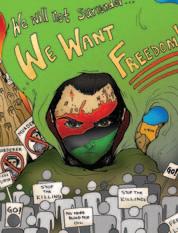
6. Board to the future: A look into the future of technology at Pierce College.
Divine Intervention: Jeremiah shares his story of surviving homelessness and drug addiction by becoming a Church Representative.

12. Room for All-Ages: This all-ages movement has brought a sober safe haven for teens in the valley.
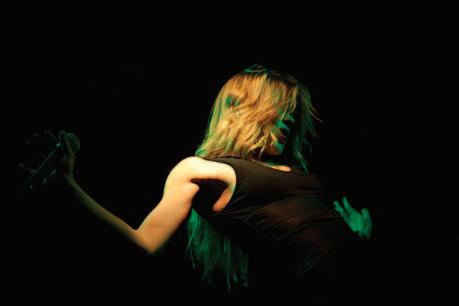
16. Hollywood Screams Peace: Once a year in Hollywood, answerla.org marches down the streets to put a end to war.
Pushing Boundaries:
Reigning from Hell, Mich., Gina and the Eastern Block create unique dance beats for the soul.
24. That’s So Organic:
Smart, Healthy, and on the go! Check out a restaurant made completely from organic products!
26. A Little Piece of Broadway: CSUN gets an all new performing arts building that is the first of its kind in the San Fernando Valley.
Photo Essay:
Chris never connected to the gender norms dictated by society. Chris feels more like a spork.
Paws for a Cause:
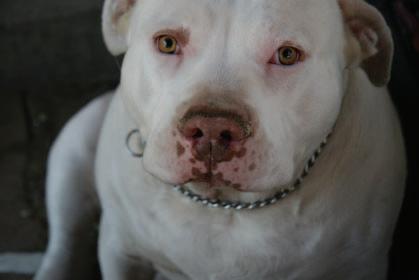
A Vietnam Vet continues to save lives one paw at a time.
32. Modify Me:

Body modification is explored, including implants, suspension, ear shaping/stretching and scarring.


34. KPCRadio.com:




The Bull teams up with the radio station to bring you shows, songs, and stories from print straight to your CD player!

The ‘Arab Spring’ is the coined term for the 2010-11 wave of political unrest throughout the Middle East. From Tunisia to Egypt, Bahrain and Yemen, the citizens of Arab and Islamic nations throughout the
4 The bull (Revolution)

region have risen against their governments.
This widespread demand for democratic rule across the Middle East could mark a turning point for a region fraught with political turmoil, violence and war; a region that has been a critical strategic interest on the world stage for thousands of years.
Governments in the Middle East are notorious for corruption,
whether they are authoritarian regimes of dictators or thin facsimiles of democracy, mere masks for puppet administrations under the thumb of foreign powers.
Neither form of government is satisfactory, and neither serve the interests of their constituent peoples, many of whom are deprived even the most basic of human rights.
And besides the abuses of government that have become such a norm, there is also the issue of fundamentalism to consider. People, some educated, some poor, all angry, have resorted to jihad and militancy in an attempt to seize power for themselves.
Driven by anger and, perhaps, a sense of impotency and helplessness, people are using
violence and fear mongering as the measure of first resort.
Extremism in the Middle East has complicated and impacted every facet of foreign policy, because even in the end, a corrupt government is preferable over terrorism, at least in the minds of the West.
Still, for the majority of people living in the Middle East, terrorized by government and fundamentalists alike, there is little hope of empowerment – true empowerment, and not the vision of power through violence.
That is what makes the Arab Spring so remarkable. For the first time in recent memory, the people of the Middle East – the young, the middle class, the idealistic – are marching in the streets, speaking truth to power regardless of their government’s attempts to silence and subdue.
Putting aside the IED for incriminating viral videos, the propaganda tape for the live blog is what makes the Arab Spring so hopeful.

This movement has already sent shock waves throughout the rest of the way, not only for its characteristic nonviolence, but for the fact that it’s working.
The protests in Egypt rode in on the fervent energy of the Tunisian protests at the end of 2010, targeting Egyptian president Mubarak and his secret police, the abuses of government and the censorship of the people.
Egypt’s revolution was extensively covered by the international press, Al Jazeera played an important role from a media standpoint with their

intensive coverage, and the Internet played a starring role as the link between fellow protesters and an information vehicle to the world.
What made the resistance movement in Egypt against President Hosni Mubarak so captivating to the rest of the world was the demographic of the movement itself – young, educated and technically savvy middle-class youth and women – as well as the ingenuity of the protesters.
When the Egypt government flipped the “Internet kill switch” that barred Egyptians from most Internet and phone services, the people got creative, organizing in IRC chatrooms and sending fax-to-Internet messages in code to revolutionaries and press alike.



Despite the Mubarak regime’s attempts to suppress rebellion, the government was eventually no match against the persistence of the youth of Egypt – and, like the Tunisian president before him, Mubarak also resigned.
Now in the months following the ousting of Mubarak, women struggle to maintain the strong role that they played in the revolution, which has turned to the business of rebuilding the country.
While the protests were secular philosophy, the Muslim Brotherhood (one of the oldest and most influential Islamic movements in the world) has begun to take root in postMubarak Egypt.
The Brotherhood is banned from political activity in Egypt, under a law constituted
Population: 6.5 million people



Libyan Military: Approximately 40,000 soldiers
Libyan refugees in Bordering countries: Approximately 180,000
by Mubarak that restricts organizations with religious backgrounds and intent from forming political parties – a law Mubarak passed after the Brotherhood’s party, Ikhwan, won 20% of the seats in the Egyptian legislation in 2005.

This constitutional repression of all opposition movements is partly what fueled the public ire against Mubarak, but it was only until the revolution drew to a close that the Brotherhood resurfaced in the Egypt political landscape and offered public support to the rebels.
This resurfacing has drawn concern from the West over the possible future power of an organization whose most popular slogan is “Islam is the solution.”

The Arab Spring thus far had been nonviolent on the side of the protesters themselves, something uncharacteristic of most political uprisings in that part of the world.
But in the oil-rich nation of Libya and, as of March 25, the republic of Syria, violence has sparked on both sides of the conflict between government oppression and public resistance.
Libya’s current leader, Col. Muammar el-Qaddafi, has asserted his intention to wage an extended war against the rebels.
Libyan military and Qaddafi’s remaining supporters are currently laying siege to rebel controlled-towns whilst Qaddafi remains sequestered in Tripoli, surrounded on all sides by rebels armed with AK-47s and a violent disgust with his regime’s violent response to what had initially been peaceful protests.
The United States (regardless of its economic woes or China’s rising star) still enjoys great influence on the world stage, as the major contributor of both money and firepower in the U.N. Security Council.
Qaddafi’s violent response to protesters has sparked international outrage and, for the first time, the United States is taking a military stance in a
Middle Eastern nation with full backing from the international community.
This support likely bolstered President Obama’s own resolve to act on behalf of the Libyan resistance movement against Qaddafi, establishing a no fly zone over the country in cooperation with a largely French-led coalition.
But President Obama has toed many a delicate line in dealing with the Arab Spring and all of its consequences for the world at large. The removed but supportive stance that the U.S. took in regards to the protests in Egypt, Tunisia and Bahrain were appropriate and non-military.
Currently, the combined military actions of the U.S. and allies in the Libya is being turned over to the hands of NATO, and the United States is not taking a clear leadership role in the effort.
And in now Syria, with Syrian troops firing on civilians in several cities, it is unclear just how proactive a role the U.S. will now play in an increasingly bloody spring.
Whatever the president chooses next, it cannot be toward an occupation – not when the U.S. is currently entrenched in two separate Middle Eastern countries.
The U.S. and its allies must be retrospective and forward thinking in this now-NATO led effort in the region: they must have a clearly defined goal in mind, a point of withdrawal, and the understanding that no nation has ever benefited from prolonged occupation, most especially not in the Middle East.
The world finds itself at a crucial juncture in history, with several Middle Eastern countries embroiled in civil conflict on an incredible and interwoven scale.
Whatever the outcome may be, this moment, this turning point, belongs to the people of the Middle East, the young and idealistic and brave. In retrospect, we can say that much.
Pierce College is under construction in more ways than one. A group of teachers calling themselves the “Smart Classroom Taskforce” are striving to make a difference in every classroom at Pierce.
Bill Duxler, David Schamus, and Bob Martinez helped create the “North of Mall” project. The project you’ve already seen going underway is not just
rebuilding, but in fact creating state-ofthe-art ‘SMART’ classrooms.
These SMART Classrooms have three components: There is a computer, a SMART Board and survey system. The three connect together to provide what Bill Duxler, Pierce College’s Chair of Physics and Planetary Sciences Department, hopes will revolutionize the way teachers will be able to present material to their students.
Students don’t have to worry about the boards costing them a dime either.
“The SMART Classrooms have been paid for by tax payer approved bonds, so any rise in tuition is the state’s deal,” says Mark Henderson, Pierce College’s IT Manager. The “North of Mall” project doesn’t end at its namesake either.
The Smart Classroom Taskforce (SCT) hopes to make every classroom on the Pierce campus a SMART Classroom. So just how do these classrooms work?
One thing that has always seemed to elude technological advancement is the whiteboard. They became popular in the 1990s and have seen no advancement since. Even that was an improvement over blackboards, which were first introduced in 1801.
This is where the SMART Board comes in: It connects to a computer and overlays the computer’s screen onto a touch screen. This opens up many possibilities for teachers.
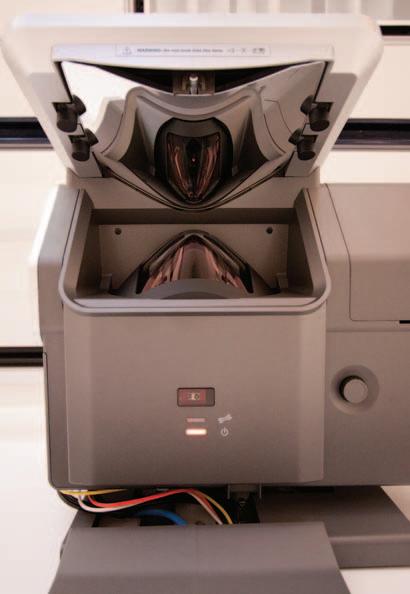
“We have a demonstration SMART Board in one of classrooms for the faculty, and every teacher that uses it is excited afterward,” said Duxler. This is because of the staggering amount of features the board has.
The SMART Board’s main attraction is that it combines a white board, projector and computer. Having the Internet readily available for a teacher to use is a small feature for the smart class. A teacher will be able to save anything they put onto the SMART Board and send it to Modular Object Oriented Dynamic Learning Environment, also known as Moodle. Moodle is essentially an online extension of a classroom, which many students are finding useful. “I use what my teacher puts on Moodle all the time,” said Oscar Gonzalez, a physics 6 student.
Don’t think that this gives a student a free pass to miss class, as Pierce is not legally permitted to have the audio from a class on its website without closed captioning, according to Schamus, an assistant professor in Pierce College‘s Computer Science, Information and Technology Department. The SMART Board’s other features are still impressive.
The SMART Board can use its own software alongside anything that is already on the computer. This means that not only can teachers still use PowerPoint and Word, but they can also implement the
New technology in the classroom will change the way students learnLIGHTSHOW - A projector sits atop a SMART Board ready to be used in a physics class.
dynamic SMART software.
This software allows someone to draw a diagram on the SMART Board with a special pen or even with their finger. These special pens don’t use ink and don’t smell like dry-erase markers.

SMART Boards are not only technologically advanced, they are also better for the environment than their predecessors. The pens used with the SMART Board are only there so you can still make the right motions when writing. There’s no chalk dust or marker fumes, and no markers means no marker solvent evaporating into the atmosphere. Students with dust allergies don’t have to worry about the SMART Board either. Aside from dust, the SMART Board stays relatively clean as well.
According to Schamus, all it takes to run the SMART Board is
already present in almost every classroom at Pierce. The only necessary addition is the SMART Board itself and some software. Sadly, the SMART Board uses more electricity than its forbearers but less physical resources; that alone makes the SMART Board more eco-friendly. Just being “green” is not enough for the SMART board to edge out its competition.
Duxler held a demonstration for the SMART Board to show how easy it is to use. Everyone who tried the SMART Board knew how to use it in 10 minutes or less. Margaret Wessling, a Physics 6 instructor at Pierce, said that it makes teaching easier. One of Wessling’s favorite features is the Clicker Response System. With it, Wessling can ask her students a question and get their answers back anonymously and in real time. This allows her to see if her students understand the content being taught.
Students who have classes with the SMART Board also agree that it is a step forward. “It does make the class easier because she can always go back and put new things and then save it and e-mail it to us,” said Ani Jehidzian, one of Wessling’s students. This feature was a favorite amongst most of Wessling’s students, however, the students did find a few drawbacks to the SMART classroom.
The major complaint on the SMART Classroom was that the board is tiny. With classrooms having as many as four white boards, the downgrade to just one seems steep. For now, the SMART Board at Pierce is a test of sorts. The SMART Boards at Pierce will measure 6.5 ft × 4.2 ft.
The other problem with the SMART Board is that it is bound to a single function at any given time. This can feel limiting to teachers who are used to having a white board display some information while they provide the rest via projector. The SMART Boards that Pierce will have can have two people work on them simultaneously, which would address the problems students have with the current SMART Board.
According to Duxler, “Pierce College students are going to have some of the most advanced, beautiful SMART Classrooms that any student could have anywhere in the country.”
(Spring 2011) The Bull 7
“Pierce College students are going to have some of the most advanced, beautiful Smart classrooms that any student could have anywhere in the country.”
— Bill DuxlerQUANTUM LEARNING - Physics Professor Margaret Wessling uses a SMART Board to instruct her Physics 6 class at Pierce College. Written by: Kari Golden



“[Crack] took me away from my children. I would do anything to get a hit.”
- Jeremiah JohnsonViictorious- Jeremiah Johnson stands outside the Union Rescue Mission in Skid Row as two unidentified locals share a pipe. Jeremiah, a former resident and crack addict, gives back to the people who helped him regain control of his life. DISCUSS- Jeremiah Johnson sits down and discusses his day with a resident during lunch time. RESCUED- A lone resident stands outside The Union Rescue Mission’s women’s entrance in downtown Los Angeles.
Black pumps and leather dress shoes click and thump against the pavement as men and women bustle across a crowded crosswalk. Along downtown’s Los Angeles Street, windows sparkle and glare as buildings seem to lurk and shroud the city like a cloak of security.
San Julien Street, with its busted walls, littered concrete, cracked windows and ignored street signs. Clusters of men and women lean against doorframes and empty spaces as others sporadically cross the street with blind eyes to oncoming traffic. Black hoodies and blazer jackets cover layers of clothing; layers of thickened scars. There is no sense of time or being, yet they all belong, encased among each other. This is the epicenter of Skid Row.
Faded pink and green rise steadily toward the rooftop, with small windows like tiny freckles facing this way and that. Abstract in design, the Union Rescue Mission has two entrances: One for women, and one for men. The lobby is home to dozens of filled chairs and hushed voices. The onlookers stare ahead to a small TV as an ad for long lasting mascara blasts from the screen.
A little boy with wild brown hair and soft eyes runs across the hallway. “Dwight!” his father yells. The boy pauses and lowers his head.
Enter Jeremiah Johnson.
He is a handsome man, although not of staggering height, he is fairly tall. His brown skin, smooth and delicate, bares a few scars. These scars aren’t as deep as his chocolate eyes that seldom greet yours. It’s as if for a moment there is a union, then they snap back into their own extraordinary vision.
He wears a light purple button up shirt along with black slacks and glistening dress shoes. Around his neck is a badge with a picture and his name.
As church relations representative
of the Union Rescue Mission, Jeremiah Johnson bares a similar scar to those of the homeless on Skid Row in downtown, home to one of the densest populations in the United States.
About 46 percent of the homeless population is centrally located within the metropolitan areas in Los Angeles County and areas like Skid Row, says Sarah Mawhorter. A 2011 Master of Planning Candidate and grad student of USC’s School of Policy, Planning and Development, Mawhorter has studied how the Los Angeles Public Health system divides planning areas, as well as the amount of nonprofit housing for the homeless in relation to Skid Row.
Although there are a lot of resources and money concentrated toward the Skid Row area, “The amount of organizations available are disproportionate to the most dense areas of the homeless population,” Sarah says.
There have been many attempts to try and diminish the homeless population residing within the streets of Downtown Los Angeles. Within the last few years, there has been a plethora of sprouting organizations and laws, such as the Safer City Initiative, which focuses on the upkeep of the city streets.
“Most people support nonprofit for the homeless in their community,” says Sarah. “In the last 10 years, business and districts are realizing it’s good for them to try to [solve] homelessness in their areas.”
San Julien Street alone is the birthplace of many organizations specifically designed to aid the homeless such as Los Angeles Mission, Midnight Mission, Weingart Center Association and the Union Rescue Mission.
The Union Rescue Mission is one of the most successful missions in the area; it’s spiritual and has a very holistic approach,” says Jeremiah.
The mission’s barren walls and high ceilings echo with hope and resilience
toward reparation of Skid Row’s homeless community.
As Jeremiah sits cross-legged in the mission’s chapel staring intently into the blue hue of its walls, flashes of days living recklessly and being homeless on the streets of Los Angeles flash before his eyes.
It began with the death of his mother, not his birth mother he says. His birth mother was an addict and an alcoholic. Jeremiah was sent to live with his grandparents at an early age in the suburbs of Compton in a grand five-bedroom house along with their other children, his aunts and uncles. Being the youngest of several children, he was plastered with attention. “I was spoiled,” he says.
Christmas dinners and family get togethers were normal in the Johnson house. His fondest memory is of his sisters dressing his brother, Bobbie, in a red polka dot dress and white pumps. Bobbie ran around the house yipping and hollering, tossing around a belt.
“We were dying laughing,” he says, throwing his head back and grinning from ear to ear. His sisters then opened the sliding glass door and pushed Bobbie outside. At that moment, their mother pulled up in the driveway, saw Bobbie standing there and said holding her chest, “Lord Jesus, my boy’s a punk.”
Jeremiah’s eyes twinkle and crease in the corners as he recalls his happy childhood.
After the death of his father, his mother was diagnosed with cancer when Jeremiah was 16-years-old. The devastation of losing his mother was so great it was like “[God] had taken my silver spoon away,” he says. Jeremiah pauses for a brief moment as if to seize a distant memory buried beneath mounds of dust. For a long time, he did not share this loss with anyone. “I was bitter,” he says.
From the time he was 16, that bitterness and rebellious attitude led
(Spring 2011) The Bull 9
Red. Green. Walk.
Jeremiah Johnson’s past led him on a journey to step out from the dark and into the light through Skid Row
Jeremiah into a downward spiral.
Jeremiah turned to stealing. Cars were his vice. “Not only was I into a neighbor’s car, I was into taking them,” he says. He once tried to steal a lady’s purse, but “That didn’t turn out too great; she hit me in the head with it.”
Jeremiah had also been in and out of jail more than he could remember. The first time, in 1980, he took the blame for someone else’s burglary. Sitting back in his chair, staring up at the ceiling of the mission’s chapel, he sighs and says, “[Prison] was an intense experience.”
“Because the court system is overwhelmed with many cases, most parole agents just throw you in jail without even glancing at your case,” he says.
From that moment on, Jeremiah’s rebellious attitude developed into an addiction for danger and fast things. “[Since the first time I was in prison] I had been going in and out of jail consistently,” he says.
Besides countless acts of recklessness, he encountered knives, gunfire and simple mistakes that led him to prolonged stays in the hospital. On one occasion, he had stolen a vehicle and the owner ran him down, firing nonstop rounds at the car and Jeremiah. “One bullet only grazed my coat,” he says, pointing to his left shoulder. Jeremiah had also been stabbed in the side as a result of a drunken brawl with a friend. “We had bought a few beers and were messing around on the piano when it just got crazy,” he says. Jeremiah spent four months recovering from the wound.
At the age of 18, he had his first child. Taking care of his girlfriend and his newborn son was his main concern. He did what he could to take care of them by doing odd jobs here and there, as well as run a towing company for a brief while. Though he ran a company, no one would hire him because of his ragged looks and criminal background.
Jeremiah began turning to alcohol and drugs. His drug of choice was crack cocaine.
Jeremiah buried himself within the dark and dank corners of a crack house in San Bernardino. There would be days he would not eat and lurk within the shadows, waiting for his next fix.
“[Crack] took me away from my children. I would do anything to get a hit,” he says. Jeremiah runs his finger down a
protruding scar along his temple. “I was dealing, smoking and out of control. I was dirty. I was so ashamed I didn’t want anyone to see me.” Because Jeremiah was so wrapped in dealing and consuming he became the “holiday and weekend dad” to his children.
Meanwhile, outside of the mission, a man in a blue faded ripped jersey leans over to pick up a plastic bottle nestled by the curbside. Jeremiah, like many residents of Skid Row, had to build makeshift shelters and do the best with what he had. He would sleep on the sidewalk, resting his fragile body against the coolness of the
clothes and a freshly shaven face. Though the encounters with shady characters became few and rare, Jeremiah would pick at old scars and constantly find himself in situations like his troubled past. Brown grew weary and decided she had enough.
On a sticky summer day with a chilled beer in hand, he walked outside onto the front porch and saw Brown nesting in a chair beneath the shade. She reached a hand out to him. “Come here. I love you like my son, but you are killing me. I can’t help you anymore,” she said. A shot of pain jolted through Jeremiah’s body. His eyes glistened as water formed at the base of his lids. “It was like losing my mother all over again,” Jeremiah says as he grasps at his chest, “ I was broken at that point.”
After the encounter with Brown, Jeremiah for the first time, acknowledged that he was out of control and needed to seek further help. He packed his bags and set out on a new journey: a journey to stitch old wounds and start anew.
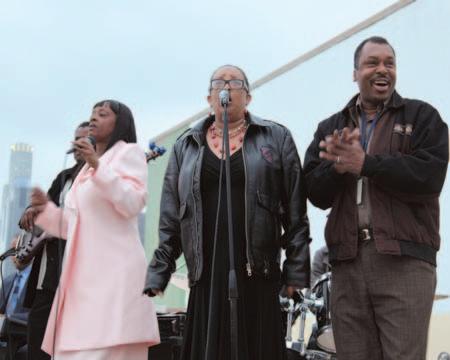
concrete, staring at the stars hoping that things would get better.
“I ended up very bitter. I was determined not to be a bum even though I was in someone else’s eyes,” says Jeremiah.
Jeremiah’s mother had passed many years ago, yet there were a handful of other women who played a large role in his life. After seeing that Jeremiah was not like the others, Violet Brown took him in when he was about 35-years-old. Brown was the mom of the neighborhood, and a “lady that wouldn’t mess around.”
Although Jeremiah would still hang out on street corners with his friends and sling dope, he began to slowly heal himself. He realized the first thing he had to change was his image and the way people perceived him. There was not a day that would go by when Jeremiah didn’t have his hair slicked back with clean
There were countless missions and shelters Jeremiah had stayed in all over Los Angeles County. He never took their programs seriously and would either be kicked out or leave. A friend brought him to the Union Rescue Mission, where he was thoroughly impressed by the dedication of their staff, particularly a worker by the name of Gilbert. After Jeremiah was enrolled into the mission, like many others, he tried leaving through the back door, but “I just couldn’t move my legs,” he says.
In the beginning, Jeremiah was buying time. Days went by like months, and months like years until one day he walked by the chapel and saw the minister singing and praying. Jeremiah was paralyzed and could not shake himself free of the chapel’s embrace. The ringing of music penetrated his ears, and words of the lord pierced his soul. That night, Jeremiah got on his knees and bowed his head against his clasped fingers. “I asked God to help me,” he says trembling as a tear slid over a scar under his eye. “If you’re real, show me, let me know.”
Jeremiah glances around the ashy blue walls of the chapel, and gives a subtle nod. He unfolds his legs and leans forward. “Everything changed from that day. The Lord changed me. I couldn’t have changed my life without God,” he says.
After hearing the strength and healing power behind the minister‘s voice through song, Jeremiah unlocked his inner passion for creating his own music. At first it started with a few others picking up instruments and collaborating. Then Jeremiah began writing his own lyrics and eventually recorded his first CD titled “Journeys of Mercy.”
“I thought I was Michael Jackson,” he says and lets out a sharp laugh, loudly slapping his hands together. Jeremiah became leader of the Music of Ministry within the mission.
“[Jeremiah] is a great singer, I feel so much joy when he performs,” says Monsibaez.
Alexandra Monsibaez is Gifts-inKind Representative for the Union Rescue mission. Six years ago, she roamed the streets of Los Angeles in search of meaning and hope to enter life. Through the Ready to Work program, which aims to help people with criminal history and disfigured pasts get jobs, she found her calling working for the Union Rescue
Mission. “I felt like I found my home,” she says.
After three years of sobriety, Jeremiah searched for his kids. There was an innate fear that they would reject him, yet he tossed those fears aside and found both his daughter and son whom welcomed him with open arms. “At that moment, I knew [God] was real. He gave me what I wanted the most: my children back,” he says. Five years after their reunion, his son of about 30 and daughter, 27, keep in contact on a regular basis.
Jeremiah became the church relations representative within two years of completing the mission’s program. It has been about six years now in this position, and he loves every day of it.


“I’ve seen people’s lives transform. It gives me purpose. After all that I have been through, it’s worth it,” he says.
Once outside in the open air, the robust man in a blue faded ripped jersey walks up with a charming smile. Jeremiah greets him by name as if they were childhood friends.
Reflection- Jeremiah Johnson views the downtown area from the roof of the Union Rescue Mission. Johnson, a recovering drug addict, now works at Union Rescue Mission in order to give back to the community that he credits with saving his life. (Spring 2011) The Bull 11 Cooking- Jeremiah Johnson slices tomatoes for the kitchen during the Union Rescue Mission’s busy lunchtime rush in Skid Row.
cross from the football field at Granada Hills Charter High School, three wiry teenage boys assemble the marquee at the First Presbyterian Church to read “The Breathing Room.” Inside the fellowship hall, a youthful man with a kind face covered in a short scruffy golden beard with warm brown eyes directs the boys. 29-year-old Justin Souza is the founder and heart behind The Breathing Room.
In November 2009, The Breathing Room became the newest addition to the list of all-ages music venues in the LA area. This is a dream come true for Souza, who has had the desire to open up an all-ages venue since he was a youngster. The closest all-ages spot to catch a show where he grew up was 45 minutes away.
Souza often found himself isolated in his interest in independent music as a young man growing up in a small town in Central California. “It was the coolest thing ever if I could find a ride to Fresno and get to a show,” says Souza. “The best time of my life as a teenager was being at a show, that feeling of excitement and experiencing live music as a young person.” The importance of that has stuck with him his entire life.
The San Fernando Valley lacked a place for young people to hang out where they feel a sense of belonging and community, according to Souza. “Music brings people together and there is a human need to connect tangibly and in person with people,” says Souza. Social networking and texting has taken away many young people’s abilities to interact on a human level. Souza’s passion drove him to create a space in the valley for young people.
The Breathing Room’s name comes from the idea of being a breath of fresh air in a community that is saturated in billboards, traffic, streetlights and strip malls. “Sometimes you just need to escape that environment, and we are that breath of fresh air,” says Souza. His personal beliefs are consistent with that of The Breathing Room.
As a member of the First Presbyterian Church in Granada Hills, Souza volunteered as a youth advisor for six years with junior high and high school kids. The youth facility started to develop over the years with sound and lighting equipment, so Souza teamed up with the youth director and used the resources available after making a proposal to the church that they embraced with
enthusiasm.
“They think it’s one of the most exciting things that the church has ever been able to be a part of,” says Souza. In the fellowship hall of the church, brown carpet crawls halfway up the walls to meet the stucco that lines the vaulted ceiling. Once a month, the
at the House of Blues. Five high school kids, who are also musicians, serve as the stage crew every month. The warmhearted feeling that Souza gets from the smiles on young patrons’ faces is more than enough compensation for him. He is a mentor and a friend to the kids.
Isaiah Tejada, 18, has become a fixture at The Breathing Room since the first time he stepped through the door. He was surprised when Souza contacted him directly after he sent an e-mail to see if his band, Broad Awake, could open a show at The Breathing Room more than a year ago.

volunteer crew transforms this room into The Breathing Room.
The sound engineering, ticketing and concessions are all volunteer run. In fact, the only paid personnel are the professional security guards who also provide security
He is now a volunteer that assists with sound checks and getting the bands’ equipment set up in the afternoon before the show. “Justin and I got to know each other through The Breathing Room, and we are really good friends now,” says Tejada. “The Breathing Room is a safe and cool place to play your music for your friends.” The care and attention that bands receive at The Breathing Room is uncommon to most LA venues, according to Isaiah.
There are two rooms set up specifically for the bands in the backstage area of The Breathing Room. One door leads to the

“the best time of my life as a teenager was being at a show, that feeling of excitement and experiencing live music as a young person.” — Justin SouzaMentoring- Justin Souza, founder of The Breathing Room in Granada Hills, Calif., directs Isaiah Tejada on stage set up. Photo by Amber-Rose Kelly
catering room with a safari themed paint job, complete with zebras, elephants and gorillas. This is where they set up the catered meal that is brought in for the bands before each show. The second door leads to the green room equipped with plush couches, a TV and a foosball table where the bands can chill. This is the kind of unique environment that Souza provides at The Breathing Room.
Souza has reached out to Kevin Erickson, director of the All-Ages Movement Project (AMP), to offer himself up as a resource for the cause. The Breathing Room is right in line with AMP’s philosophy. “I love what they are doing, and if there’s any way that I can get more involved or if they
have any job openings, I’m down,” says Souza. He feels a sense of responsibility to young people in his community and everywhere.
“Every kid deserves a place where they can go and participate in live music regardless of whether they’re in a big or small city, whether your community is well re sourced or impoverished,” says 30-year-old Erickson. This has become the foundation for many all-ages venues that have cropped up across the nation in recent years and registered with the AMP.
Nestled in downtown Seattle, right around the corner from the Space Needle, is where you will find AMP. It is a social network designed specifically by young people and for young people to connect through music and art in their communities, but they offer much more than a hub to find all-ages music venues nearest you. AMP encourages young people to get involved in their own community’s live music and art culture; they also give you the tools to do so.
A collection of nine writers from different youth arts and music organizations put their knowledge and experience together in a book called, “In Every Town: An AllAges Music Manualfesto.” This book has
helped ignite and propel all-ages music and arts venues across the nation. The majority of these are run on a volunteer basis by and for young people. “Community organizations are uniquely built to serve their locales and are shaped by their founders,” according to chapter one. No one knows this better than Souza.

A wealth of knowledge is available in Souza with his professional background. Having interned with the director of tour development at the House of Blues, assisted a booking agent at International Creative Management, and now managing tour merchandise at Bands Merch for the past five years. “I try to help out bands that are
14 The bull (Revolution)
“Sometimes you just need to escape...and we are that breath of fresh air.”
— Justin Souza
“The Breathing Room is a safe and cool place to play your music for your friends.”
— Isaiah TejadaSpotlight- Local band, R5, sets up for their show at The Breathing Room in Granada Hills, Calif. Photo by Jose Romero
touring professionally and still trying to figure out how to be a business,” says Souza. He also provides an invaluable service to young people interested in getting involved in the music industry.
Souza and Tejada share ideas now about how to make The Breathing Room better for the bands that play there and the people in the community. “Sometimes we share bands with each other to figure out new possibilities for the next month’s show,” says Tejada. “I guess he is a mentor, but he’s also a really good friend.” Souza is deliberate in cultivating a positive atmosphere for young people at The Breathing Room.
Every all-ages venue is designed specifically to fit the needs of the community and the environment in which it’s established. The Breathing Room is an example of the type of innovation and radical thinking that AMP fosters. “When you’re invested in the community you’re in, you want to dig your heels in and protect it,” says Erickson. The Breathing Room has given many young people in the San Fernando Valley a place to call home.

For more info on the breathing room: http://www.facebook.com/thebreathingroomallages more info on the breathing room:
(Spring 2011) The Bull

“When you’re invested in the community you’re in, you want to dig your heels in and protect it.” — Kevin Erickson.Showtime- All-ages patrons crowd into The Breathing Room located in Granada Hills, Calif. Photo by Jose Romero Plug in- Justin Souza prepares his daughter, Adelaide, with ear plugs before a show at The Breathing Room in Granada Hills, Calif. Photo by Amber-Rose Kelly
- Ron kovic, Vietnam War Veteran

Story by Jessica Conway

“I wake up to war everyday.”
The streets of Hollywood are a stage for the world to see the citizens’ passion about the war overseas(top) Rage - Retired Army Sgt. Baker and Retired Marine Lcpl. Arrey chanted against the United States involvement in the Middle East during the Annual Anti-War protest in Hollywood, Calif. Photo by Joe Kukuczka (left) Not Forgotten - Carolyn Mallory sits in front of the Mann Chinese Theatre in Hollywood, Calif. protesting the war, the cause of her son’s early death in Iraq. Photo by Joe Kukuczka
o justice, no peace! Know justice, know peace! This was the chant that echoed through the streets of Hollywood during their annual protest.
It was a protest on Hollywood and Vine meant to bring about change in the world.
The streets were filled with thousands of people, young and old of all races, who were unhappy with the choices our government is making.
“If this were truly a democracy, the war would end,” said Jim Lafferty, member of the National Lawyers Guild.
The protest continued with a native dance led by Aztec dancers alongside Chief Longwalker, followed by several speakers.
Protesters were angry about budget cuts, conflicts in the Middle East, and the need for racial and class equality. Many in the crowd were directly related to someone who had been recruited to war or even killed.
Several emotions coursed through the crowd, even regret towards voting President Barack Obama into office.
“Fool me once, shame on me; fool me twice, shame on you,” said one angry
protestor. “[Obama] will not be voted into office again.”

At 1 p.m., police prepared themselves by surrounding the area as the crowd began to march, carrying signs and passing out flyers demanding for our troops to return home.
The chanting continued, “Gay, straight, black, white—same struggle, same fight.”
“It’s pretty peaceful for the amount of people here; let’s just hope it ends on a good note,” said a police officer who withheld their name.
The crowd marched past the CNN building to let one of the largest media networks hear their anger, then past the intersection of Hollywood Boulevard and Highland Avenue. Finally, they stopped in front of the Mann Chinese Theater where another stage was set up.

More speakers stepped up on the stage, both pride and anger filled each speaker’s voice.
“We are going to stand up and fight back with ambition and numbers,” said Eman Kaleq, UC Irvine student.
Guest speaker, Chris Shiflett of the Foo Fighters, spoke and performed an acoustic song on war.
“It’s time. Let’s stand together today in unity for peace,” said Shiflett.
The protest was meant to inspire people to stand up for what they believe in. This action reflects that no matter how small the event may seem, as it grows it can diminish government control over the nation.
“We must stand up and ask ourselves not ‘who has their billions in the White House or Congress’, but ‘who is marching in the streets’,” said Lafferty.
Next, war veteran Ron Kovic explained how his life was after becoming paralyzed 43 years ago in the Vietnam War. Kovic is the subject of the book, “Born on the Fourth of July.”
“I wake up to war everyday,” he stated.
He believed we were not exempt from the tragedies happening in Egypt currently, suggesting we need to fight together for what we want.
The protest ended with our troops’ loved ones staging a sit-in in front of the Chinese Theater, holding boots, signs and pictures to let authorities recognize that what they stand for will not be ignored, but will one day change the way of the world. The event drew to a close as these loved ones were detained by police in front of the theater entrance.
(Spring 2011) The Bull 17 (Spring 2011) The Bull 17
“We are going to stand up and fight back with ambition and numbers.”
- Eman Kaleq, UC Irvine student(top)Blinded - Demonstrators black bag themselves during the Anti-War protest in Hollywood, Calif. walked in jump suits representing the prisoners in Guantanamo Bay. Photo by Joe Kukuczka (left) Hear Me Now - Activists from AnswerLA. org speak out against the war in the Middle East in Hollywood, Calif. Photo by Amber-Rose Kelly
From the moment we are born, doctors ascribe us a gender by exclaiming, “It’s a Boy!” or “It’s a girl!” and from then on we are expected to suit that role. However, social scientists today draw the line between sex and gender, and for good reason. Sex is purely biological, while gender is constructed in such a way that it de fi nes the way we speak, act and go about our daily lives. These strictly de fi ned roles leave a minority of society’s members on the wayside, either itching to cross the line into their intrinsically desired role or to simply fi nd a gray zone in between. In that neutral zone, you would fi nd Chris Murphy, a junior at Cal State University, Los Angeles.
As long as Chris can remember, there was never a desire to be a girl—make-up, dresses, gossip. On the same chord, Chris did not desire to become a boy either—Chris just wanted to be Chris. To fi t into these norms Chris has to appear one way to feel safe, and in an attempt to do this Chris began taking testosterone. With this new appearance of facial hair and body changes Chris appears to be a normal man in society.

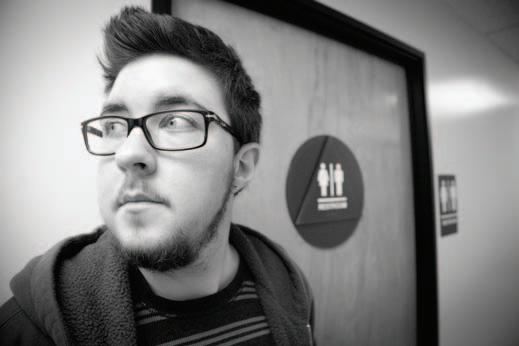
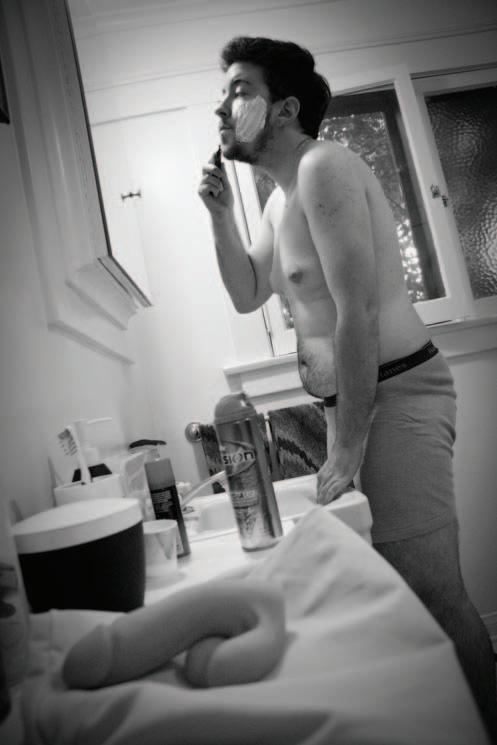 By Amber-Rose Kelly
By Amber-Rose Kelly
OB-GYN- Getting a pap smear when you appear to be male can be an extremely awkward situation for trans men or genderqueer individuals, Chris explains. Not only do you face apprehension and confusion from medical staff, but the intake forms leave little room for those who can't easily check "male" or "female."
Kate- Chris talks about Kate and their relationship.“All of a sudden I have four hands instead of two and if I need help I can ask her. I think we have a beautiful relationship and I do not want to let her go.”
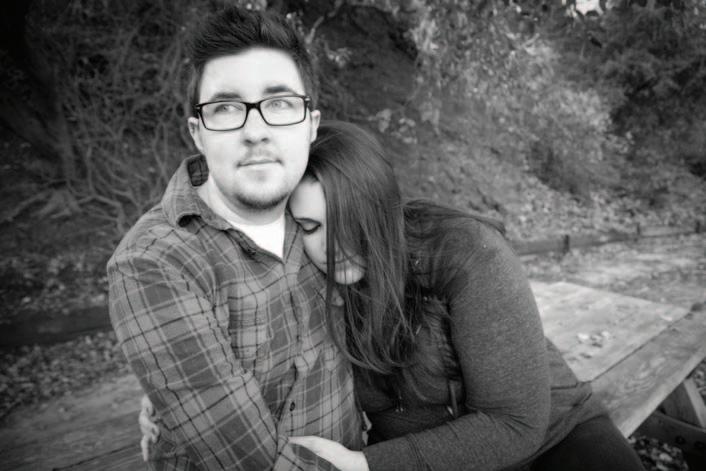
Testosterone: Chris said, “ I’ve been taking testosterone since August 12, 2008, so as of this moment it has been two years since my first injection.”

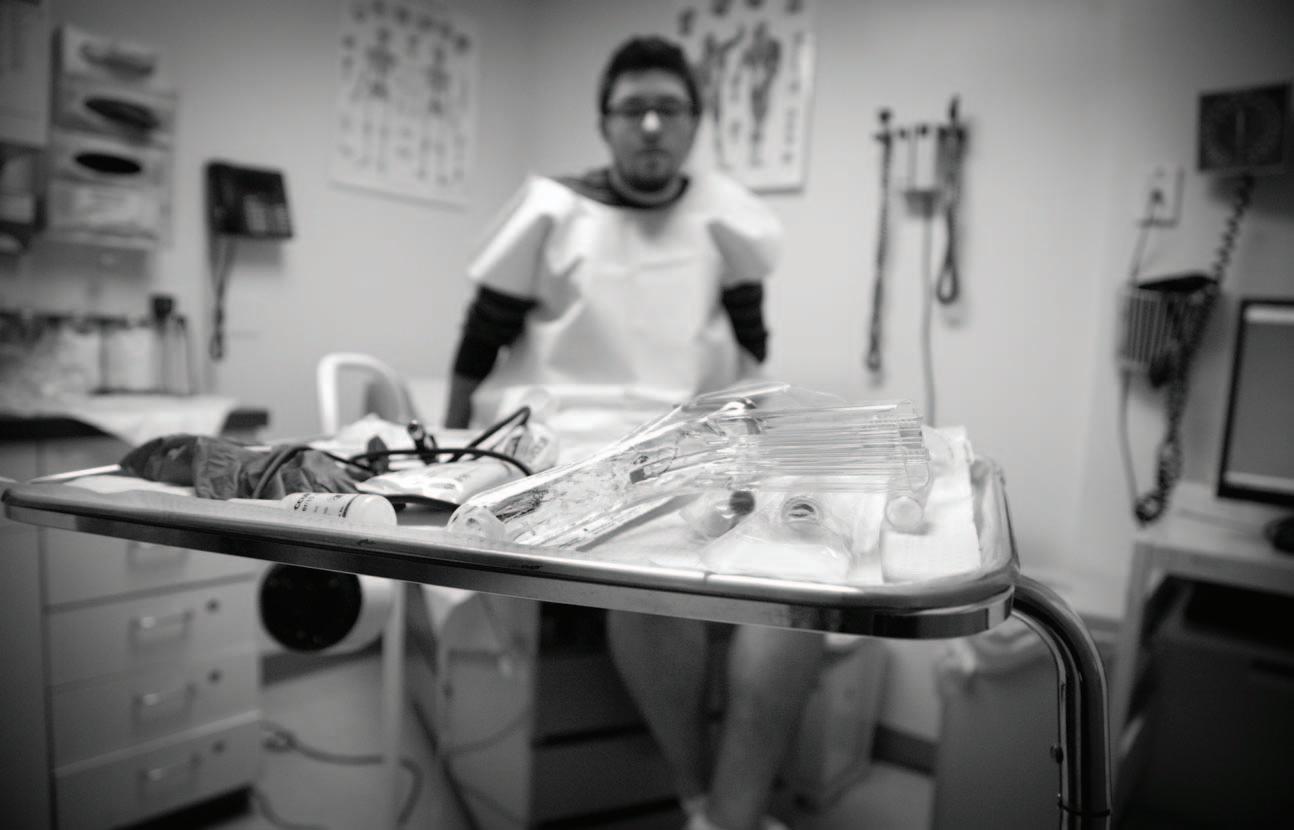
Photos by Joe Kukuczka
The skies are pulled over he skies are over with dark gloomy clouds on with dark clouds on an unusually cold, rainy day an cold, on the Sunset Strip in West on the Sunset in West Hollywood.
The raindrops become larger and The become and heavier as the night grows longer, heavier as the grows making everything in sight glisten in with colorful sharpness. Puddles with colorful Puddles gathered on the streets reflect the on the streets re ect neon signs of liquor stores and neon of stores and flickering marquees of tiny clubs ickering marquees of tiny clubs seeded along the road. seeded the road.
A marquee reads, “Gina and the A marquee “Gina and the Eastern Block,” in black solid letters, Eastern in black solid slightly off tilt and backlit by an off off tilt and backlit an off white glow. white
The bouncer sits inside the entrance, out of the dampness of the entrance, out of the dampness of the rain, as patrons stand outside in rain- rain, as patrons stand outside in rainappropriate party gear, cupping their party gear, their hands to keep warm. hands to warm.
Inside the tiny world known as The Inside the world known as The
Viper Room, the lights are turned the are turned down low and the floor is packed from oor is from wall to wall with twenty-somethings, wall to wall with drinks in hand.
The loud thumping sounds of The loud sounds of hip-hop music in the background music in the gradually quiets and the black, heavy and the black, curtains split to expose the stage. curtains to expose the stage. Whistles and cheers echo throughout the club. the club.

To the left side of the stage is the To the left side of the stage is the band’s guitarist, Todd Weinstock, 32, band’s Todd Weinstock, 32, from New York City. from New York
He holds a sea-foam green Fender He holds a sea-foam green Fender Jazzmaster guitar in hand. His short Jazzmaster in hand. His short curly hair, tight black jeans, tattered hair, black tattered v-neck T-shirt and unlaced black boots make him look like he was was pulled off the stage of a ’70s punk pulled off the stage of a ’70s punk rock band from London.
Behind him is a stack of Marshall a amps towering halfway to the ceiling, amps to the hooked up to nearly a dozen guitar hooked up to a dozen
pedals covering the floor just at the the oor at the edge of the stage. of the stage.
Not to be outdone, at the back
Not to be at the back center of the stage sits a seven-piece, center of the stage sits a midnight blue DW drum kit and in blue DW drum kit and in the driver ’s seat is Marc Jordan, 38, the driver’s seat is Marc from Los Angeles. from Los
In true drummer style, he’s
In true drummer he’s dressed in green plaid pants and a dressed in green pants and a vintage rock band t-shirt, which will rock band t-shirt, which will later come off. His hair is curly and later come off. His hair is and he wears a 10 o’clock shadow. To his wears a right sits a Mac laptop ready to play sits a Mac to loops.
With one click of the space bar, the With one click of the space the loops begin to play loud and hard as to loud and hard as the crowd cheers.
A petite woman dressed in black A woman dressed in black tights, black high heel boots and a black heel boots and a tight black mini-dress enters the black mini-dress enters the stage with a slow sultry walk to the stage with a slow walk to the microphone.
Her long strawberry blonde hair is Her blonde hair is intentionally messy and swoops across messy and swoops across her face, just barely covering her eyes. her face, just barely covering her eyes. She commands the stage and oozes She commands the stage and oozes confidence as the packed audience dence as the audience stares in awe. stares awe.
“We love you, Gina!” yells out a “We love you, Gina!” out a male fan. He is barely heard over the male fan. He is heard over the distorted guitar and massive sound of distorted and massive sound of the drums. the

She doesn’t skip a beat, winks at She doesn’t a beat, winks at the fan, and with a nod to her band the the and with a nod to her band the boys join the loop and she starts her the and she starts her song with bold lyrics and commanding song with bold lyrics and dance moves. moves.
any sort began in early childhood, any sort in childhood, where she and her friends would record homemade videos performing record homemade videos popular songs accompanied by self- songs selfchoreographed routines at the age of routines at the age of 10.
They not only rehearsed the moves not rehearsed the moves and perfected their singing, but also and their but also put together outfits to match their put out ts to performances.
Throughout her school years, Katon her school years, Katon knew she wanted to be something knew she wanted to be extraordinary and unlike everyone and unlike everyone else.
Later, while other students in her Later, while other students in her high school were busy studying for school were for their SAT exams, Katon had different their SAT exams, Katon had different plans in mind. in mind.
“I told the guidance counselor at “I told the counselor at my high school that I wanted to be my school that I wanted to be Madonna,” she remembers with a she remembers with a laugh. “They were a little bit worried.” were a little bit worried.”
After graduating high school in
After school in 2002, Katon auditioned for the EDGE 2002, Katon auditioned for the EDGE program for dancers, which would program for dancers, which would take her to Los Angeles for an intense take her to Los for an intense curriculum for performers in the curriculum for in the dance industry. dance
So many dream of being on this
So many dream of being on this same stage and seeing their names on same stage and their names on the flickering marquees of Hollywood marquees of Hollywood clubs; confirmation that they have con rmation that have somehow made it in this city saturated somehow made it in this saturated with up-and-coming artists, musicians, with artists, musicians, and actors. actors.
Gina Katon, a 26 year-old dancer Gina Katon, a 26 dancer and singer from Hell, Mich., did just and from Hell, Mich., did that.
“I really did come from Hell,” she “I did come from Hell,” she says and bursts out laughing. says and bursts out
But she didn’t have a hellish time But a “making it.” it.”
Her desire to be a performer of Her desire to be a of
“I didn’t take it seriously that time “I didn’t take it that time around,” says Katon. “So I didn’t around,” says Katon. “So I didn’t make the cut.”
After failing to get a spot in the After to get a spot in the program, Katon changed her focus. program, Katon her focus.
She applied for college in New York She for in New York and attended one year of performing and attended one year of arts classes, quickly realizing that arts classes, that school life outside of dance just wasn’t school life outside of dance just wasn’t what she wanted to do. to
In 2003, she auditioned once again In she auditioned once for the EDGE program. for the EDGE program.
“This time I knew I really wanted “This time I knew I wanted it so I put my all into my audition,” it so I put my all into my audition,” she says. “Thankfully, I got the she says. I got the scholarship.”
(Spring 2011) The Bull 21
M a r c J o r d a n Marc Jordan D r u m s DrumsAfter learning that she got the scholarship, like so many
After that she got the like so many aspiring musicians, actors, writers and artists, Katon gathered musicians, actors, writers and artists, Katon her every possession, packed it into a car, and traveled 3,000 her every it into a car, and traveled 3,000 miles to the Mecca of stardom that is Hollywood. miles to the Mecca of stardom that is
But it wasn’t an easy transition for Katon. But it wasn’t an easy transition for Katon.
“I lived in this dingy “I lived in this dingy hotel where the neighbors hotel where the would shoot up heroin and would shoot up heroin and do all sorts of drugs, and do all sorts of and yell and fight on a nightly and on a basis,” she reminisces. “It she reminisces. “It was horrible! There were was were sirens and gunshots on sirens and on random nights. I wanted random I wanted to hide or run away from to hide or run away from that place.” that
After a grueling year of living in Venice Beach, going to After a year of in Venice Beach, to practices and classes three times a day at the Los Angeles Dance and classes three times a at the Los Dance Center, Katon completed the EDGE dance program and received Center, Katon completed the EDGE dance program and received not only the honor of completion, but also the connections needed not the honor of but also the connections needed to launch her dancing career. to launch her career.
“It was amazing,” she says. “We got so many networking “It was she says. “We got so many possibilities with agents, artists and the entire dance network.” with agents, artists and the entire dance network.” While still in the EDGE program in 2006, Katon met fellow While still in the EDGE program in 2006, Katon met fellow dancer Ace Harper, 23, from Hollywood. Harper approached dancer Ace from
her to join a group she was forming for an all girl singing dance her to a group she was for an all dance group, backed by seasoned rock musicians. group, backed seasoned rock musicians.
After officially auditioning for the dancing rock group, Katon cially auditioning for the dancing rock group, Katon became one of four members of the Darling Stilettos. became one of four members of the Stilettos.
Decked out in vinyl, barely-there outfits, 6-inch heels, faux-
Decked out in out ts, 6-inch fauxhawks and abs that made every gender jealous, the girls every the belted out rock anthems and out mesmerized their audiences with dance moves only a group with dance moves a group called Darling Stilettos can pull called Stilettos can off.
The girls opened for big- The for name acts including Slash and name acts Slash and the star studded Roxy Theater the star studded Roxy Theater regulars, Camp Freddy.
In 2009 while on tour with the group, she and another In 2009 while on tour with the group, she and another member attended a Lady Gaga concert. Katon watched in awe member attended a concert. Katon watched in awe and was reminded that she wanted to improve as a performer and was reminded that she wanted to as a performer and do more than just blend into the stage. and do more than blend into the stage.
“I wanted to be in the spotlight. I wanted to do everything: “I wanted to be in the I wanted to do sing, dance and just perform on my own stage,” she says. dance and on my own stage,” she says.
In early 2010, she broke the news to her band-mates that she In 2010, she broke the news to her band-mates that she was leaving the Darling Stilettos to pursue a solo career and to was the Stilettos to pursue a solo career and to expand her talent in a different direction. her talent in a different direction.
Katon’s departure from the group wasn’t taken lightly, but it Katon’s departure from the group wasn’t taken but it wasn’t unexpected either. wasn’t either.
During this time, the group ended up breaking up all together this time, the group ended up up all and replacing all but one original member; Harper. and all but one member; Harper.
“I was terrified to leave,” she recalls. “But, I wanted to do “I was ed to she recalls. I wanted to do something nobody can describe, and fit into no genre. I want my can and t into no genre. I want my own genre.” own
“It annoys me when follow in other artists’ Katon says. “Just because all the Rihanna songs are popular, Katon says. “Just because all the Rihanna songs are doesn’t mean you have to try and sound like her.” doesn’t mean you have to try and sound like her.”
“It annoys me when people follow in other artists’ footsteps,”
She knew this was the only way to step out from the shadows She knew this was the only way to step out from the shadows of a group and to make a splash as an individual artist. of a group and to make a as an individual artist.
“It’s your job [as an artist] to find a way to stand out from the
“It’s your [as an artist] to nd a way to stand out from the rest,” says says Brad Fuhrman, a Los Angeles-based band manager of Brad Fuhrman, a Los band manager of Sanctuary Artist Management Group who works with such Sanctuary Artist Management Group who works with such musicians as ZZ Top, Tommy Lee and others. “Artists that make musicians as ZZ Top, Tommy Lee and others. “Artists that make it in Hollywood are doing something different and unique. Often it in Hollywood are doing something different and unique. Often times you can see the star quality in people right away, you times you can see the star in away, you can tell they know what they’re doing and they won’t settle for can tell know what and won’t settle for anything less than success.” less than success.”
Since the beginning of 2010, Katon, Jordan and Weinstock
Since the of 2010, Katon, Jordan and Weinstock have spent their time concocting a style of music nobody can have spent their time a of music can really describe. They barely follow the standard process of really describe. They barely follow the standard process of putting songs together. songs
“Marc [Jordan] and I will sit at the studio and he’ll me a beat and we go from there. Then we send it out to Todd me a beat and we go from there. Then we send it out to Todd [Weinstock] in New York and let him do whatever he wants to in New York and let him do whatever he wants to it,” Katon says. it,” Katon says.
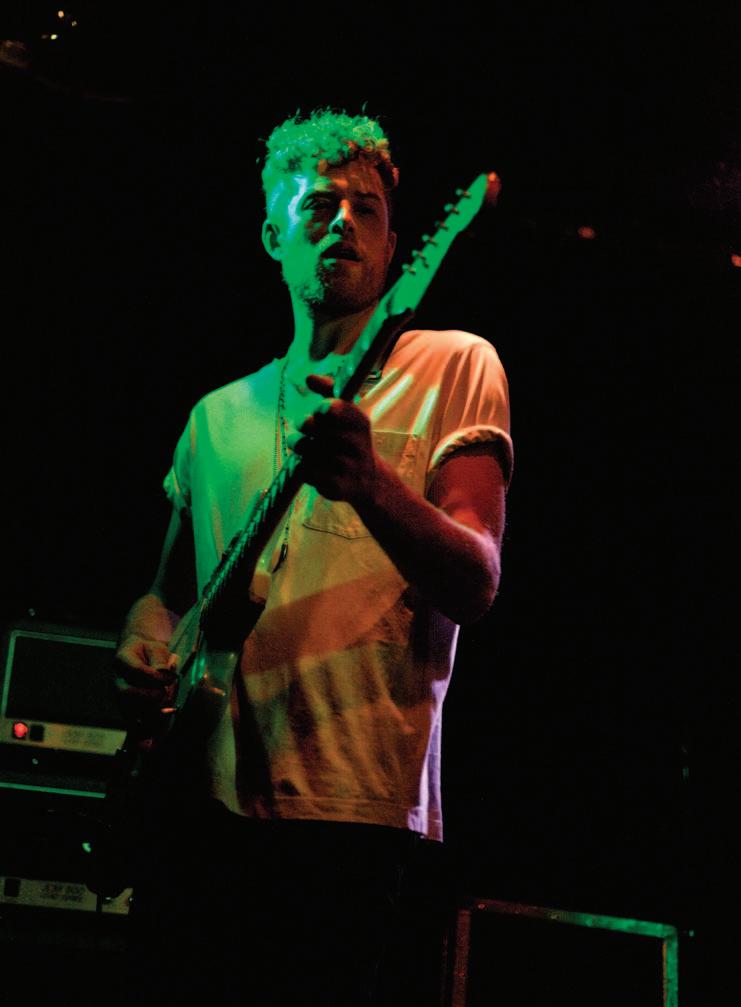
“Marc [Jordan] and I will sit at the studio and he’ll just give
“He comes up with some kind of crazy sends it back to us and we just run with it,” she continues. back to us and we run with it,” she continues.
“He usually comes up with some kind of crazy magic, sends it
Even the band struggles to describe their music style.
Even the band to describe their music
“I like to call it ‘sweaty chic’,” says Jordan. “It’s ‘artsy pop
“I like to call it says Jordan. “It’s pop decadence-to-fuck-to’ music.”
“I think that’s what excites people about this music,” Katon
“I think that’s what excites about this music,” Katon says. “It shocks them because they’ve never heard anything like says. “It shocks them because never heard like it before.”
“I wanted to do something nobody can describe wanted to do something nobody can describe and fit into no genre. I want my own genre.” and fit into no genre. I want my own
- Gina KatonLead singer of Gina and the Eastern Block singer of and the
T o d d W e i n s t o c k Todd Weinstock G u i t a r Guitar
Gina and the Eastern Block are no strangers to shock Gina and the Eastern Block are no strangers to shock value. During their debut performance at a New York City value. their debut at a New York club, they woke the crowd up by doing their own rendition club, woke the crowd up their own rendition of a controversial song called “Fuck The Pain Away” by of a controversial song called “Fuck The Pain Away” Peaches.
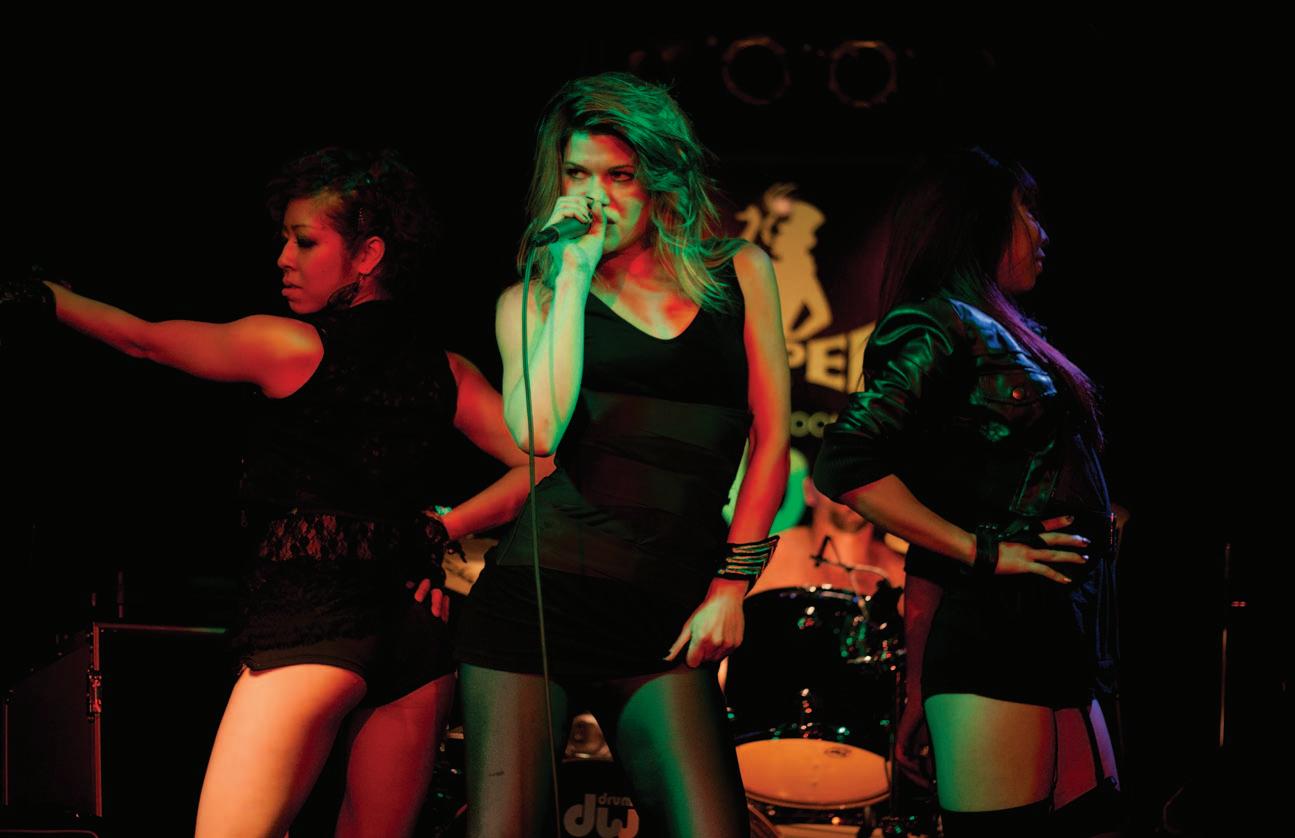
“I ended up humping the floor and stroking the mic stand “I ended up the oor and the mic stand at the end of the song,” she remembers. at the end of the she remembers.
“People in the crowd didn’t know what to think, and that’s in the crowd didn’t know what to and that’s exactly what I wanted. I want them to talk about it after the what I wanted. I want them to talk about it after the show,” Katon says with a laugh show,” Katon says with a
The band appeared for the first time as “Gina and the The band for the rst as Eastern Block” in late November of 2010. With a handful of Eastern 2010. a original songs, they booked their first gig in New York, and songs, booked their rst in New York, and have since played almost 10 shows. have since almost 10 shows.
Their quick success and popularity is unusual in the music Their success and is unusual in the music industry, as most bands tend to spend months working non- as most bands tend to spend months nonpaying gigs in unknown, half-empty venues. in unknown, venues.
“It’s as hard as it sounds,” says Fuhrman. “Brand new “It’s as hard as it sounds,” says Fuhrman. “Brand new bands rarely book more than five substantial shows in their bands book more than ve first six months, but you have to make sure you believe in rst six months, but you have to make sure you believe in what you’re doing and don’t take no for an answer. You’re what and don’t take no for an answer. You’re in Hollywood, if you’re doing something right you will be in Hollywood, if you’re you will be heard!”
That is exactly what Gina and her block do on a daily That is what Gina and her block do on a basis. Between booking their gigs themselves, trying out basis. Between their out dancers for the shows, handing out flyers, rehearsing, dancers for the shows, out yers, recording, writing, and rubbing elbows with the right people, and elbows with the there’s little time left to be a starving artist in Hollywood. there’s little time left to be a artist in
“So much of being a budding musician in Hollywood is “So much of being a budding musician in Hollywood is just doing the leg-work,” says Katon. “We don’t mind it at the says Katon. “We don’t mind it at all. We’ve met so many people along all our roads that it’s all. We’ve met so many all our roads that it’s like talking to friends when we book gigs. People actually like to friends when we book People actually approach us to come play their venues!” us to come their venues!”
A. Celina Denkins, who has booked international talent for A. Celina who has booked international talent for the last six years for the world famous Whisky-A-Go-Go and the last six years for the world famous and has seen such names as Buckcherry, The Killers and Taylor has seen such names as The Killers and Swift become household names, explains that no matter your Swift become household names, that no matter your status, you have to remember that when dealing with a venue, status, you have to remember that when with a venue, you are an invited guest. If you do everything right, you will you are an invited guest. If you do you will always be welcomed back and will always be put at the top of be welcomed back and will be put at the top of the venues booking priority list. the venues list.
However, according to Fuhrman, being on the priority However, to Fuhrman, on the list doesn’t always mean more money, as ticket sales have list doesn’t mean more money, as ticket sales have declined in recent years due to the economy. declined in recent years due to the economy.
“I once heard the quote, ‘never work harder for a band
“I once heard the quote, ‘never work harder for a band than they work for themselves’,” says Fuhrman. “[Managers] than work for themselves’,” says Fuhrman. want to work with bands who are willing to get their hands want to work with bands who are to get their hands dirty and are serious about the business. You won’t succeed if and are serious about the business. You won’t succeed if you aren’t willing to commit 100 percent and work your asses you aren’t to commit 100 percent and work your asses off.”
“[Fans] are more likely to spend the same $75 seeing 5 “[Fans] are more likely to spend the same $75 5 smaller local bands and get more music for their money.” smaller local bands and get more music for their Denkins still has hope for musicians though.
Denkins still has for musicians
“Music and alcohol are recession proof! What the economy “Music and alcohol are recession What the economy has affected is the amount of presale tickets bands are able has affected is the amount of presale tickets bands are able to sell, but all in all, people enjoy drinking and listening to to sell, but all in all, and to music whether they are happy, sad, rich or broke.” music whether are rich or broke.”
Indeed they do. Indeed do.

The cuisine of the “typical American life style” has been evolving for the past 10 years, new foods have been introduced while others have gone through extensive modification. Everywhere one looks, propaganda for weight loss is unavoidable. What if there was a place that one could go to that was 100% good for your body. A place where the foods were filled with omega 3 and vitamins A, E and C. O!Burger, is Los Angeles’ first all organic restaurant, located in the heart of West Hollywood, it offers healthy food at an affordable price. Not only is the food all natural but the products, supplies and decor of the restaurant are all recycled products. O!Burger is the pioneer in launching all organic and all natural restaurants in the Los Angeles community.
O!Burger was founded by Gourmet Chef Andrew Saboil and family film Producer Martha Chang. Both Saboil and Chang wanted a place that was local that offered
24 The bull (Revolution)
people the food they enjoy, and had healthy benefits, so the opening of O!Burger began. In 2008 O!Burger opened its doors to the Los Angeles community. While the owners were nervous as to how this new revolutionary restaurant would take off little did they know that they were starting a chain of successful healthy restaurants.
The idea of an organic menu is nothing new to the people of Los Angeles, so if O!Burger was to make an impression it would have to make quite a remarkable one. The owners didn’t just want a place that is healthy for the person, but healthy for the environment. Not only is their healthy food approved by the USDA, everything a customer uses, touches and sees in the restaurant is recycled. “Going green” is not just the theme of the restaurant, but the goal. It comes as no surprise that the paint that is used on the walls is low-VOC paint. So the fumes will not poison the air and it keeps toxic paint from entering landfills. In
Story by: Katie Moran Photos By; Joshua Cowanturn reducing the demand for more paint to be made. The flooring of the restaurant comes from old barns in Vermont and Maine. Napkins and paper products come from recycled paper, and the utensils and packaging comes from biodegradable natural material, sugar cane. In addition, the straws and plastic cups are made from corn, and recycled products. “Our intent is to be as eco-friendly as possible. We use packaging that is made from renewable resources that are recyclable, compostable and/or biodegradable. Our cleaning products are green and non-toxic. We use AFM lead-free, zero VOC Safecoat paint, the same kind used in schools and hospitals.” says Saboil. The tap water that is available for customers use is filtered five times, so you could put sea water through the filtration system and make it drinkable in the purest form.
The owners of the revolutionary restaurant are just as fascinating as their store. O!Burger is co-owned by Andy Saboil,
a gourmet private chef, and Martha Chang, a movie producer. For 20 years Saboil has been a personal chef for celebrities and various socialites, traveling around the world catering. So when the decision to open a restaurant arose, he was more than qualified. Saboil’s father owned restaurants his whole life and he has always known his way around the kitchen. Growing up in South Africa he is cultured with different foods and incorporates his culture into his cooking. Saboil dedicates his time everyday at the restaurant not just as an owner but as a cook, waiter, host, and even bus boy.
When Saboil and Chang wanted to open an all organic restaurant they both knew it would be a challenge. The location had to be somewhere that would appeal to a crowd that “eats healthy,” and enjoys unique food. In the heart of Hollywood is where the first O!Burger opened right off of Santa Monica Blvd. and Highland Avenue O!Burger offers its unique cuisine. Having a location where the diversity of the community is overwhelming the customers range from everyday ordinary people to A-List television stars. “I had the yummiest veggie burger today from O!Burger in West Hollywood. The burger was handmade with roasted corn, and it was crispy...Now, I haven’t really scoured LA for veggie burgers, but of all of the ones I’ve tried,
this was hands down the best,” says Alicia Silverstone on her food blog, The Kind Life. Alicia Silverstone is among many celebrities who have found themselves enjoying O!Burgers food. Shaun White, professional snow boarder, is often a frequent visitor, as is Steven Tyler.


So, what’s the point of organic? Organic food is 100% pesticide free. Even when the food is in factories, it is not injected with chemicals. The work that is put into organic and all natural farms is a long process, as the cost of organic food is more expensive. For farms to become certified organic farms grow, the soil that is used must be 100% pesticide free for 5 years, it making it “clean soil”. So farmers take sections of their farms and shut them off section by section to clean their soil, to begin growing organic.





The beef, however, is flown in from Uruguay, where each cow is given 2 football fields of just pure grass to graze on. Grass is the alternate to feeding cows corn, which is what many beef farms feed their livestock. Corn is naturally hard to digest in the human body, and when feeding it to cows its making the beef harder to digest. This can lead to digestive problems and potential health problems. O!Burger guarantees no hormone injected or chemical fed animals, just all natural. It also appeals to vegans and those who are lactose intolerant, offering
soy burgers. In addition Martha and Andrew didn’t just want the food to be good for you, but also the beverage you are enjoying with your meal. The soda is also organic, no fructose, or high amounts of sugar.



O!Burgers menu is the same as any other burger joint’s, although all the food is organic or made in the restaurant. The same grass fed beef, is used for the hotdogs. All the sauces that are used for the food are 100% vegan, as well as the ice cream that is used to make the shakes is soy ice cream. A lettuce wrap is available for those who are gluten-free, and various organic breads are available. In addition to enjoying the food at the restaurant, you can also purchase a “Veggie Pack,”of 4 homemade veggie burgers, filled with a special organic recipe.
Living in the “City of Change,” revolution is all around us, food, politics, movies, religion, all in hopes of being embraced by the community. O!Burger wants to give its customers the satisfaction of good food, as well as satisfaction of eating healthy food that benefits their body. Confident that his restaurant is the best and most unique, Andy Saboil is fearless, and puts 200% into every meal. “Nobody has what I have,” says Saboil.
“It’s one of the Best Burgers in Los Angeles and its number 1 for a healthy alternative to your normal diet.”
— Jeremy Meyer (Hollywood examiner)
By Friday night, the academic scenery has transformed into a little piece of Broadway. From outdoors, a tranquil courtyard with freshly planted trees luminescent with hanging lanterns and a huge four-story glass lobby is seen. There is a low rumble of multiple conversations through the crowds soon to encounter a clean and contemporary white lobby with musical reminders everywhere, from the multi level hanging ceiling panels to glass stairway railings reminiscent of piano keys.
As you walk into the auditorium the lights soften, voices lower and the smell of popcorn fills the air as the first performance begins on not just any stage, but San
Fernando Valley’s all new Performing Arts Center at Cal State University Northridge.
CSUN’s beautiful new addition will revolutionize the ambitions of this program and create a distinct location for the community to express themselves.
Although the Performing Arts Program has been around for 50 years, the work on the center didn’t begin until 2009 and opened in 2011.

Not only will the building become a modern addition to performances in the valley but it will educationally benefit the students at the university.
“It was designed to provide students and the community a large lecture hall, a new radio station space for educational resources
and the larger lecture hall for both,” said Robert Bucker,executive director of valley performing arts, .
The larger lecture hall even consists of an art gallery upstairs and a lecture area where concession candy are sold during performances.
“The pristine building will create a more natural way for students to interact with faculty and the community,” according to Jennifer Aguilera, a former student at the University.
The modern hallways with white walls and glass give a professional feel, while the seating area’s subtle lights and wood walls give a warm essence to this building, contributing a sense of inspiration.
“Our mission is to create a cultural experience akin to what’s downtown” said,Pamela Bucker, director of advertising.
The building was established on Jan. 29, 2011, with a unique stage for a wide variety of performances over it’s 36,000 square feet.
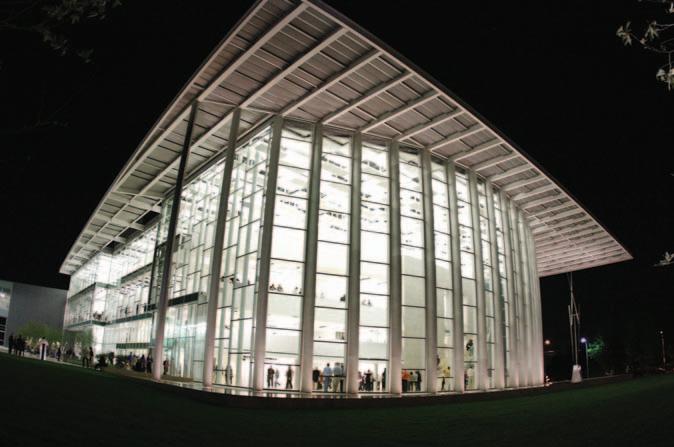
The stage features 1,700 removable red cushioned seats including swivel box seats, with three pre-set stage levels depending on the featured performances.
With over three years of construction and over $120 million spent, this new addition to the valley was the last of three major performance centers in Southern California to be built. Other Including the Walt Disney Concert Hall in Los Angeles and the Renee and Henry Segerstrom Concert Hall in Costa Mesa, both of which have auditoriums that were designed similarly to make every seat feel as if it has the best viewpoint. The seating arrangements have quality views for the ticket prices ranging from $15 to $75 depending on the chosen location.
In walking back to the courtyard another stage is concealed behind a large glass garage-like wall. The wall retracts into the ceiling making a partially
outdoor stage with a large classic black curtain that allows for outdoor performances on summer nights.
Architect Kara Hill designed the building; she has won four awards and has a PH.D. in architecture, her specialty is observatories and performance halls.

With an astonishing level of architecture this building includes over 30,000 square feet of glass for a great scenic view and has over 4,000 tons of steel.
“The design is truly unique, it is
welcoming, the west and north are both glass walls, the architect succeeded in making the inside feel as if it were out,” said Bucker, “It’s universally designed for tunable acoustics.”
The walls in the Great Hall are made up of an elastic steel material that can be tuned by tightening and loosening them to accommodate specific performances.
CSUN was not the only university to be remodeled, University of California Santa Cruz and University of California
Riverside were few among many.
“Every CSU was funded by the state for a new building ours happened to be this one,” according to Bucker.
Aside from the state funding private funds were also provided. Mike Curb, dean of donated over $1 million to help start the process.
The building will help students economically by providing job openings as ushers and custodians.
“The new building is prestigious and will change perspectives on the programs available here,” says Rafael Bondoc, Pierce College student.
Getting the word out to students about the new lecture hall and radio station room is not the only concern the administration at CSUN has, the community driven productions have a substantial amount of work and have proven to be effective.
“There is no question,” said Bucker, “Since opening week we have had six performances, two of which were sold out; this definitely proves we our successful in our community performances so far.”
Famous performers are featured at this location often from Rosanne Cash to Joan Rivers and many more to be booked.
The new Valley Performing Art’s Center contributes more culture to the city, helping the Valley rival to its neighboring communities.
“Our mission is to create a cultural experience akin to what’s downtown.”
— Pamela BuckerShowtime- Audience members walk the lobby stairs of the Valley Performing Arts Building. Photo by Joe Kukuczka Prestige- Valley Performing Arts Center Great Hall located at California State Northridge Cal State University of Northridge. Photo by Joshua Cowan
Abused, abandoned and neglected animals need your help, and Dan Garland has answered the call. Clouds loom in the sky on a windy winter day in Palmdale as you pull up to enter the Garland Rescue. As one enters the property, a volunteer is throwing trash into a giant trash bin. The barking dogs greet you as they sense every footstep nearby, especially Garland’s.
Garland started rescuing animals over 30 years ago in Long Beach where he and Mercedes Atwood started Garland Rescue with 15 dogs. Garland is a war veteran, having served in World War II, Korea, and the Vietnam wars. However, his personal war is right here on US soil; Garland’s purpose in life is to save man’s best friend. The abused, neglected and unwanted animals that roam the streets, the other fallen soldiers, need his help. Garland, 87, gets

with his two dogs and his employee, Larry, as they head off to purchase another pallet of food for all of the animals. When Garland asked if he could acquire all the old food before they destroyed it, Science Diet employees replied, “We do not donate to any animal sanctuaries, and we don’t want to be held responsible.” He even offered to sign a release of liability, yet they still refused to donate any food for the animals.
Garland enlisted in the military in
1935 and retired in 1962. For more than 30 years, he worked for the Los Angeles County. 30 seems to be the magic number for Garland. “We offer a safe haven for animals young and old; that’s what we do,” says Garland.
Garland Rescue is in dire need of monetary donations, as well as building supplies for the entire two and a half acre rescue. “The sanctuary is run entirely off of my SSI and retirement income, and we still fall short of the needed income to run the rescue,” says Garland.
Atwood is Garland’s sergeant at arms and his partner in rescue. She is a petite framed woman,65, with long grey hair and an unconditional smile. Her hands are ripened with age and hard work. “I’ve got to start cleaning the dog kennels, is it okay that we talk while I work,” she asked. Huge blue stackable bins full of newspaper line the walls as she walks to a shed that is half full of blankets and towels. “This is all we have; we need so much more and we are struggling, but we love and care for all these animals,” says Atwood.
The phone rings, and without hesitation, a powerful voice begins talking to someone on the phone and giving them advice about what to do with a rescue dog. Atwood is trying to make arrangements and make room to take in yet another homeless animal. The phone is ringing constantly while she walks through the rescue.
“We have to make sure the dogs and cats are warm especially the older ones,” say Atwood, while tying up some sweaters and making sure that
their blankets and bedding are fresh. Volunteers and employees at Garland Rescue separate what needs to be washed from what needs to be thrown away in a mounting pile of soiled linen. All of the dogs bark with delight when they hear Atwood’s voice; the voice of the person that rescued them from death itself. She calls every one of their animals by name, asking if they’re okay while their eyes beam with love and appreciation.
Atwood begins to tell the story of Pickles, one of the old cats at the rescue that she was keeping alive with IV fl uids and medicine. Pickles eventually died, but Atwood was glad that she was able to be there in her last hours to keep her comfortable. “This is what I do: Mr. Garland and I do this all on our Social Security and retirement bene fi ts, we have no funding,” says Atwood.
A lot of people talk about what they will do to help, but Atwood and Garland are all about action. “No one knows how much of a sacri fi ce this is, but it is so gratifying to know that we are making a difference,” she says.
The Garland Rescue is committed to the animals 24 hours a day. “These animals need us because they have no one,” says Atwood. “I have seen people do such horrible things to animals.” She has stacks of prayer books sitting in plastic bins in the corner labeled by year with prayers for every animal.
Stuck to the refrigerator door is a large note with a picture of money and a prayer asking God for grants and funding of $10,000 a month to run the non-kill rescue. There are several volunteers at

the rescue and a few employees that pay to keep things running 24 hours a day. “We have to be extremely careful with regards to who works with the animals because we don’t want anyone here that might abuse or be cruel to the animals,” says Garland. He would rather feed and clean every one of them himself.
The average life span for an animal that becomes available for adoption after the waiting period, which allows the owners to fi nd and reclaim their pet, is seven days or less, according to a source who was previously employed by Animal Care and Control who asked not to be identi fi ed.
If you fi nd an animal that you like and you want to extend their life, go online to the Animal Care and Control website where you can input the animals kennel number. This will extend the animal’s life for about two weeks. Animals that come in very injured or ill are usually euthanasic immediately, according to Atwood.
“There have been times that kittens less than four days old have been put to sleep,” says Atwood. “What the community doesn’t know is that the dead animals are picked up and sent to a rendering plant.” Animal shelters do assessment testing on what they consider aggressive breeds such as pit bulls, Rottweilers and German Shepherds. There are at least 3,000- to 5,000 of these breeds in the system. There have been occasions when customers come back saying that the animal they adopted was ill, and they had to take them to their veterinarian to be treated for parvo or
“I would rather feed and clean everyone of them myself, They’re all my personal pets. this is a 24-hour commitment.”
—Dan Garland
kennel cough.
Garland rescue has had an ongoing relationship with PetSmart for more than 15 years. “This helps tremendously with a lot of rescues to have such a large forum for adoption,” says Garland. The adoption fee of $200 includes spay or neutering, shots and microchips for the dogs.
Adoptions have slowed down a little with the current economic climate. “If someone, for whatever reason, decides that they can not keep their commitment of adoption, we will gladly take the animal back; we are also looking for people who

will foster animals,” says Garland. “We work together with other rescues and non–pro fi t organizations; we are all like a pipeline of information, such as Actors and Others for Animals, Rainbow Rescue, Butterhouse Foundation, Easter Seals and plenty of others,” says Garland. Atwood is working on getting Garland Rescue on cable channels when they feature pet adoptions.
“We have even tried getting grants or hiring a grant writer with no success, sometimes it feels so hopeless that we just do it ourselves, but we really need help,” says Garland. They are working on getting better with technology and becoming more Internet savvy. Garland Rescue is on Facebook and Twitter @GarlandRescue.
They will be working on a website next, but for now, you can fi nd Garland Rescue’s dogs at the Rainbow Rescue website.
Garland Rescue is standing on the front line in the war of saving man’s best friend and giving them a second chance at life. “We have taken an oath to provide love and shelter to these animals, we rehabilitate abused animals to teach them how to trust again,” says Garland. “They are all my personal pets.”


CCalifornia is known for a unique assortment of characters, and with the help of body modifiers, the sights are starting to become even more eye catching. Local shops provide many body modifications to their clients, from intricate tattoo designs to unique skin modification such as implants, scarring, suspension, branding, dermals and ear shaping.
Implants are different objects or silicone placed under the skin to create a 3D style.
Branding is a symbol or pattern burned into the skin to leave the scar as a design.
Ear shaping/Stretching is the process of changing the shape of your ear. Stretching the earlobe is the most common body modification practiced. Dermal implants can be put on almost any area on the body. The dermal is composed of two components: an anchor, which is placed under the skin, and the surface of the dermal, which is screwed into the threaded hole of the anchor. The anchor allows you to change between different shapes and styles of jewelry.

The scarring process consists of cutting or removal of the skin to leave a scar. Most of the people that participate in this modification will make sure to keep it infected and irritated to leave a better scar.

A suspension is the act of hanging a human body from hooks that have been put through body piercings. These piercings are temporary and are performed just prior to the actual suspension.
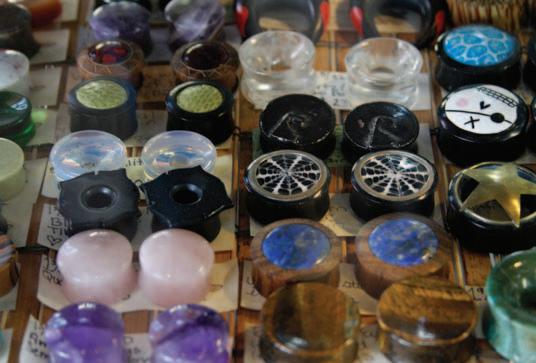

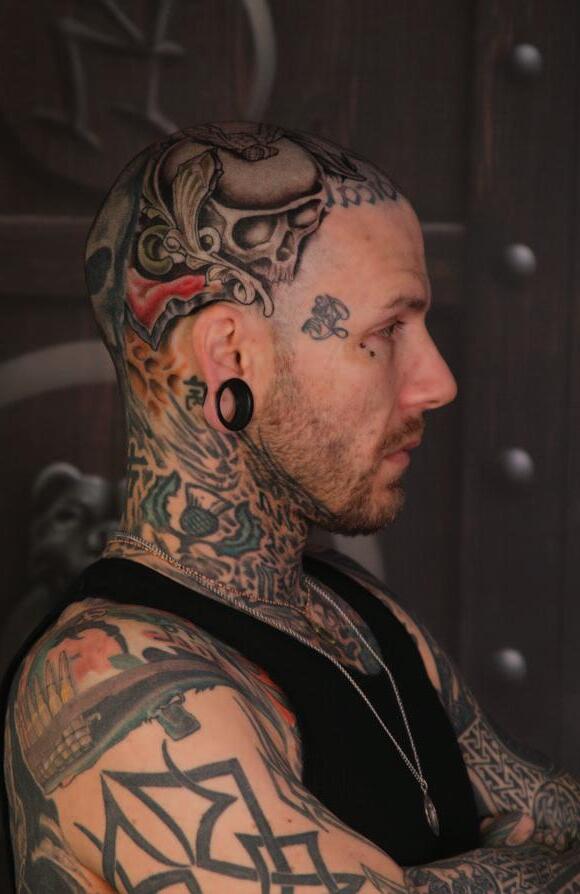 32 The bull (Revolution)
TOP LEFT- James Conway poses for a photo at Ink Kandy Tattoo in Hollywood, Calif.
TOP RIGHT- Nathan Peterson places a dermal implant into the neck of Ashley Sirizzotti at Nathan’s Tattoos and Piercing in Canoga Park, Calif. CENTER- A patron at Ink Kandy Tattoo receives a surface piercing on the ear from the hands of James Conway. BOTTOM RIGHT- Nate Rossi shows off his Implant of a star under the skin of his hand at Ink Kandy Tattoo. BOTTOM LEFT- A selection of gauges on display at Nathans Tattoos and Piercing.
32 The bull (Revolution)
TOP LEFT- James Conway poses for a photo at Ink Kandy Tattoo in Hollywood, Calif.
TOP RIGHT- Nathan Peterson places a dermal implant into the neck of Ashley Sirizzotti at Nathan’s Tattoos and Piercing in Canoga Park, Calif. CENTER- A patron at Ink Kandy Tattoo receives a surface piercing on the ear from the hands of James Conway. BOTTOM RIGHT- Nate Rossi shows off his Implant of a star under the skin of his hand at Ink Kandy Tattoo. BOTTOM LEFT- A selection of gauges on display at Nathans Tattoos and Piercing.






REVOLVING AROUND THE THEME OF REVOLUTION, THIS COMPILATION CD, WHICH IN ITS OWN RIGHT IS REVOLUTIONARY, IS FREE FOR YOUR LISTENING PLEASURE.

























KPCRADIO.COM IS A STUDENTRUN INTERNET RADIO STATION BROADCASTING SAN FERNANDO VALLEY STORIES AND NEWS FROM THE PIERCE COLLEGE CAMPUS. WE PUT COMMUNITY FIRST. JOIN US, TAKE BROADCAST 10 IN THE FALL AND LEARN WHAT IT TAKES TO BE AN ON-AIR REPORTER, TALK SHOW HOST OR DJ.










BREAKING BOUNDARIES ONLINE AND IN PRINT.







MULTIMEDIA . LIFE AND STYLE . MORE ON REVOLUTION










